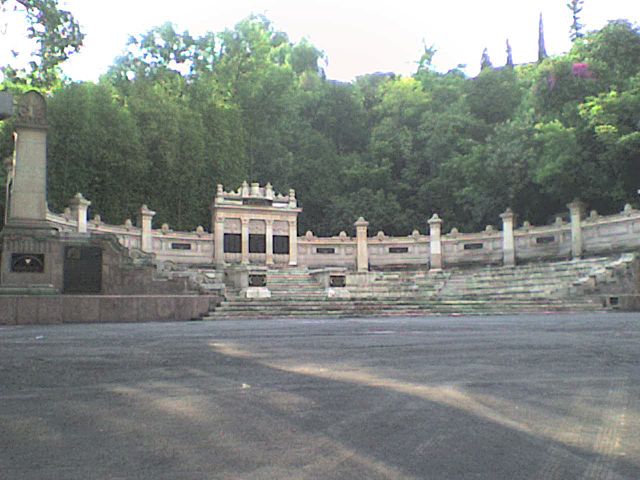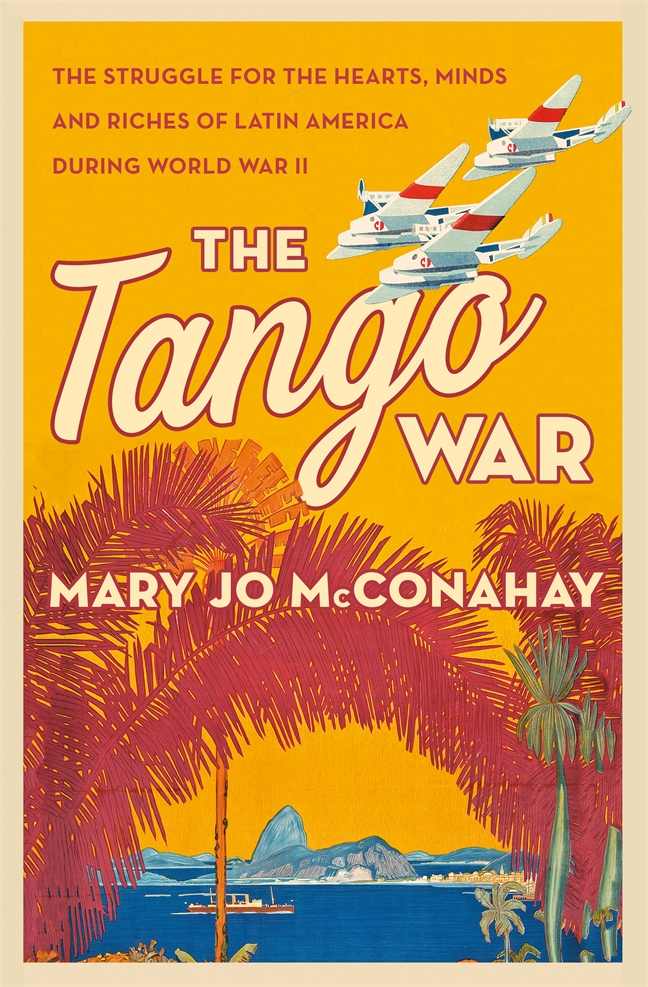by Mary Jo McConahay
In pre-Columbian times, Mexico City’s Chapultepec Park was a verdant space reserved for the rest and recreation of Aztec rulers. Today it is a fifteen-hundred-acre oasis in the middle of the largest Spanish-speaking city in the world. In the park stands a castle where six “Boy Heroes” fell, military cadets defending a hill against U.S. troops in 1847 during the Mexican-American War.
Ironically, another monument stands nearby, this one commemorating a Mexican air unit that flew under U.S. command in World War II. The Mexican Air Force Squadron 201, nicknamed the “Aztec Eagles” by its members, consisted of three hundred pilots and crew trained in the United States who made bombing runs over Luzon and Formosa in 1945 and ferried aircraft from Papua New Guinea to Pacific theater airfields for Allies fighting Japan. Eight of the Aztec Eagles were killed in the line of duty.
But don’t expect to find the monument to the World War II fliers by asking directions from Mexicans enjoying the park.
“There is a Metro station named for them, I know that,” said one person I asked, the first to show a spark of recognition about the squad.

Chapultepec’s monument in honor of the 201st Squadron. Image is in the public domain via Wikipedia.
I approached two indigenous-looking men before a giant ahuehuete, a Montezuma cypress. They said they had been praying at the tree, a species sacred to native people. We stood no more than a hundred feet from the flying Aztecs’ monument, a massive stepped semicircle standing at least a story high, but they said they had not heard of the squadron. “We do not concern ourselves with war,” said one, Tenoch, who identified himself as a Nahuatl priest.
The big monument to the Aztec Eagles and the little excitement their name arouses is a contrast that symbolizes Mexico’s split attitude toward participation in the war. Both Washington and Mexico City knew some military participation was necessary to ensure that Mexico would have a seat at the table in the new postwar world order. But for historical reasons, supporting Washington was not a popular cause among the Mexi can people. The United States was the Big Brother to the north who had taken away a large chunk of Mexican territory and threw a long shadow over the country.
Toward the war’s end, however, Mexican president Manuel Ávila Camacho found a way to support the Allies militarily with a pretext that played upon Mexican pride. In May 1942, two Mexican tankers supplying oil to the United States had been sunk by U-boats, one on the way to New York, the other returning from Pennsylvania. Mexico declared war on the Axis. In 1944, President Ávila Camacho sent the aerial fighter squadron to fight with the Allies and “to clean the national honor” for Mexico’s sunken ships.
As they trained in Texas and Idaho, the Aztec Eagles sometimes faced discrimination.
“The Americans looked down on us at least a little bit,” Captain Reynaldo Gallardo recalled in 2003 in an interview for a San Diego, California, newspaper. “They didn’t say so, but I noticed it. We made up our minds that we wouldn’t say anything, but instead would show these people what we had.”
On a combined U.S.-Mexican sortie in the Philippines, Gallardo, attached to the 58th U.S. Fighter Group, completed his mission of strafing a line of Japanese troops and vehicles. As he pulled up, he “got a little crazy” and maneuvered his plane into a celebratory roll, a move that earned him a scolding over the intercom as a “crazy Mexican.” Gallardo found this offensive and blindly challenged the offender. On the ground, he saw that the American was “three times as big and four times as heavy,” wearing a big grin on his face. They fought anyway, fortunately for Gallardo a mere tussle, but the Mexican’s spunk earned him respect among the pilots. The gladiators became fast friends, breaking the ice between the Mexican and American airmen.
After the war, the Aztec Eagles were welcomed back home with a grand parade in Mexico City before being promptly shuttled into the background of the national landscape. The Mexicans received new fighter aircraft and other war matériel through the U.S. Lend-Lease program that aided U.S. allies. But the image of a fighting partnership with Washington did not fit the Mexican profile of independence from the United States. Ávila Camacho’s successor, Miguel Alemán Valdés, turned his back on much of what his predecessor had done—and besides, no one in the ruling party wanted to entertain the prospect of war heroes competing with its handpicked, old-boy network candidates for political offices. The flying veterans faded into history, despite some ceremonial appearances over the years.
 Mexico City’s American Legion post in a charming old house in the leafy Condessa district is one of the few places the fliers are remembered. The post is a comfortable relic of another time, with a bar that opens at 2:00 p.m., a used bookstore, and memorabilia adorning the walls, including a photo of poet Alan Seeger—uncle of American folk singer Pete Seeger—who died at the Battle of the Somme in World War I. A secretary named Margarita dug out photos of the handsome young men of the Aztec Eagles for me. In some they posed with the propeller aircraft they flew, Thunderbolt single-seat fighters. In the past, Margarita said, the post hosted celebrations on Veterans Day—11/11 at 11:00 a.m.—“for those who came back alive.” On Memorial Day, the Aztec Eagles joined American Legionnaires and U.S. Marines from the embassy at a cemetery to honor the dead. Mostly, however, the fliers were forgotten warriors in a country where the man on the street had little interest in the Second World War—even though Mexico had played an important part in supplying manpower to replace U.S. agricultural workers gone to fight, and providing oil and other natural resources.
Mexico City’s American Legion post in a charming old house in the leafy Condessa district is one of the few places the fliers are remembered. The post is a comfortable relic of another time, with a bar that opens at 2:00 p.m., a used bookstore, and memorabilia adorning the walls, including a photo of poet Alan Seeger—uncle of American folk singer Pete Seeger—who died at the Battle of the Somme in World War I. A secretary named Margarita dug out photos of the handsome young men of the Aztec Eagles for me. In some they posed with the propeller aircraft they flew, Thunderbolt single-seat fighters. In the past, Margarita said, the post hosted celebrations on Veterans Day—11/11 at 11:00 a.m.—“for those who came back alive.” On Memorial Day, the Aztec Eagles joined American Legionnaires and U.S. Marines from the embassy at a cemetery to honor the dead. Mostly, however, the fliers were forgotten warriors in a country where the man on the street had little interest in the Second World War—even though Mexico had played an important part in supplying manpower to replace U.S. agricultural workers gone to fight, and providing oil and other natural resources.
“We fought in defense of sovereignty and independence of the nation,” said former sergeant Héctor Tello Pineda of Xalapa, Veracruz, in a televised interview before his death in 2017. Tello, who entered the Mexican forces at age twenty, said the experience “shaped” him for the rest of his life.
“We did our duty as soldiers, and we did it with valor and discipline for the liberty of Mexico,” he said. “For the whole world. Because in reality, it was a world war. That’s what it was called.”
Born in Chicago, MARY JO MCCONAHAY is an award-winning reporter who covered the wars in Central America and economics in the Middle East. She has traveled in seventy countries and has been fascinated by the history of World War II since childhood, when she listened to the stories of her father, a veteran U.S. Navy officer. A graduate of the University of California in Berkeley, she covers Latin America as an independent journalist. Her previous books include Maya Road and Ricochet. She lives in San Francisco.
The post The Aztec Eagles of WWII: Mexican Air Force Squadron 201 appeared first on The History Reader.
Powered by WPeMatico